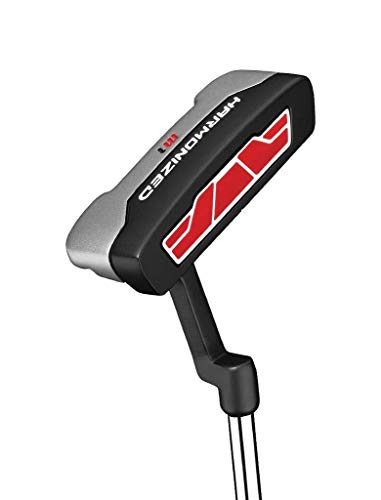Everything You Need To Know Before Choosing A Putter

Golf is a game of precision and finesse, and one of the most crucial aspects of the game lies in the short game. Putting, in particular, can make or break a golfer's scorecard. To excel in this aspect, having the right golf putter is essential. A golf putter is a specialized club designed specifically for putting, and it plays a significant role in a golfer's success on the green.
The Anatomy of a Putter
A golf putter typically consists of three main components: the head, the shaft, and the grip. The head is the most critical part of the putter, as it determines the club's performance. Putters come in various shapes and sizes, each designed to suit different putting styles and preferences.
- The head of a putter can be broadly categorized into two types: blade putters and mallet putters. Blade putters have a traditional, compact design with a thin, flat head. They offer a classic feel and are favored by golfers who prefer a more traditional look and a consistent stroke. On the other hand, mallet putters have a larger, more forgiving head shape, often with additional weight distributed around the perimeter. Mallet putters provide enhanced stability and forgiveness, making them popular among golfers who seek more forgiveness on off-center hits.
- The shaft of a putter connects the head to the grip. It can be straight or have a slight bend, known as a "shaft offset." The offset helps align the golfer's hands with the putter face, promoting a square impact at impact. The length of the shaft is another crucial factor to consider. Putters come in various lengths, ranging from 32 to 36 inches, and finding the right length that suits your height and posture is vital for consistent putting.
- Lastly, the grip is the golfer's point of contact with the putter. Grips come in different sizes, shapes, and materials, allowing golfers to find the one that feels most comfortable in their hands. A proper grip promotes a relaxed and stable stroke, ensuring better control over the putter.
Types Of Putter
Face Balanced Putters
Face Balanced putters refer to putters with a face that points upwards when you balance the shaft on your finger. This positioning ensures that the center of gravity aligns directly beneath the shaft axis. Such putters exhibit minimal opening during the backswing and closing during the follow-through, making them a preferred choice for players with a straight putting stroke.
Toe Balanced Putters
Toe Balanced putters are characterized by the toe pointing towards the ground when you balance the shaft on your finger. This design results in the center of gravity being situated away from the shaft axis. Toe balanced putters are more prone to opening and closing movements throughout the putting stroke, making them more suitable for players who have an arcing motion in their putting stroke.
It's important to note that not all putters are exclusively categorized as either face or toe balanced. Many putters fall along a spectrum, exhibiting varying degrees of toe hang. Golfers will discover that by aligning their stroke type with the appropriate balance of putter, they can achieve greater consistency on the putting greens.
Choosing the Right Putter
When it comes to golf, the importance of putting cannot be overstated. A significant portion of your score is determined by your performance on the greens. To excel in this aspect of the game, it is crucial to have the right putter in your hands. With countless options available in the market, choosing the right putter can be a daunting task. However, by considering a few key factors, you can find the perfect putter to enhance your putting game. In this article, we will guide you through the process of selecting the right putter for your needs.
Determine Your Putting Style
Before diving into the world of putters, it is essential to understand your own putting style. There are generally two types of putting strokes: straight-back, straight-through (SBST) and arcing. The SBST stroke is characterized by a straight back and straight through motion, while the arcing stroke follows an arc-like path. Identifying your putting style will help you choose a putter that complements your stroke.
Consider Putter Head Design
Putter head design plays a significant role in determining the feel and performance of the putter. There are three main types of putter head designs: blade, mallet, and peripheral weighted.
- Blade Putters: These putters have a traditional, compact design with a thin, flat clubhead. Blade putters are favored by golfers who prefer a classic look and feel. They offer more feedback and control, making them suitable for golfers with a straight-back, straight-through putting stroke.
- Mallet Putters: Mallet putters have a larger, more forgiving clubhead with a higher moment of inertia (MOI). They distribute weight around the perimeter, providing stability and reducing the effects of mishits. Mallet putters are ideal for golfers with an arcing stroke or those seeking more forgiveness and alignment assistance.
- Peripheral Weighted Putters: These putters combine elements of both blade and mallet designs. They have a blade-like appearance but feature additional weight distributed around the perimeter. Peripheral weighted putters offer a balance between feel and forgiveness, making them suitable for a wide range of golfers.
Assess Putter Length and Weight
The length and weight of a putter are crucial factors that can greatly impact your putting stroke. The standard length for a putter is around 34-35 inches, but it is essential to find a length that suits your height and posture. A putter that is too long or too short can negatively affect your alignment and stroke mechanics.
Similarly, the weight of the putter can influence your stroke. Lighter putters are generally more suitable for golfers with a faster putting tempo, while heavier putters can benefit those with a slower tempo. Experimenting with different lengths and weights will help you find the right balance for your stroke.
Test the Feel and Alignment
The feel and alignment of a putter are subjective aspects that can greatly impact your confidence and performance on the greens. When choosing a putter, it is crucial to test it out and see how it feels in your hands. Pay attention to the balance, grip, and overall comfort. A putter that feels good to you will likely inspire confidence and improve your stroke.
Additionally, consider the alignment aids on the putter. Many putters feature alignment lines or dots that can assist in aiming the putter face accurately. Find a putter with alignment features that resonate with your visual preferences and help you line up your putts more effectively.
Seek Professional Advice
If you are still unsure about which putter to choose, seeking professional advice can be immensely helpful. Golf professionals or club fitters can analyze your putting stroke, recommend suitable putter options, and even provide custom fitting services. Their expertise and knowledge can guide you towards the right putter for your game.
Price Of Putters
The price of putters can vary significantly depending on various factors such as brand, quality, materials used, and additional features. Generally, putters can range in price from around $50 to several hundred dollars.
Entry-level putters or those with basic features can be found in the lower price range, typically between $50 and $100. These putters are often made of cheaper materials and may not have advanced technologies or customization options.
Mid-range putters, priced between $100 and $200, offer better quality and more advanced features. They may have improved alignment aids, better balance, and higher-quality materials, resulting in improved performance.
High-end putters, priced above $200, are typically made by well-known brands and offer premium materials, advanced technologies, and extensive customization options. These putters are often used by professional golfers and enthusiasts who prioritize performance and precision.
Conclusion
Golf putters are an integral part of a golfer's arsenal, especially when it comes to the short game. Choosing the right putter that suits your putting style, aligns well, and feels comfortable is essential for consistent performance on the green. With practice and dedication, combined with the right putter, you can unlock the key to mastering the art of putting and elevate your golf game to new heights











